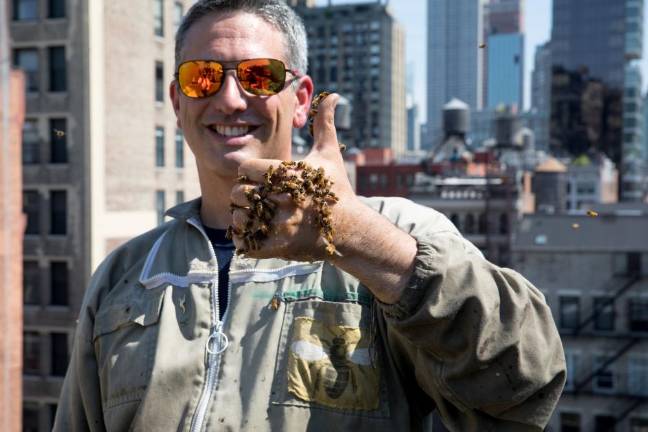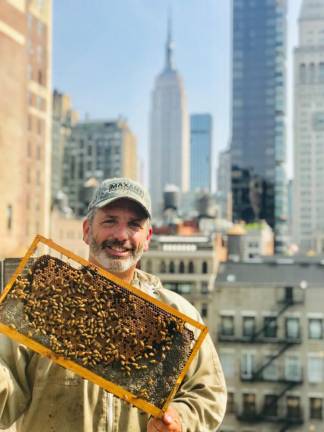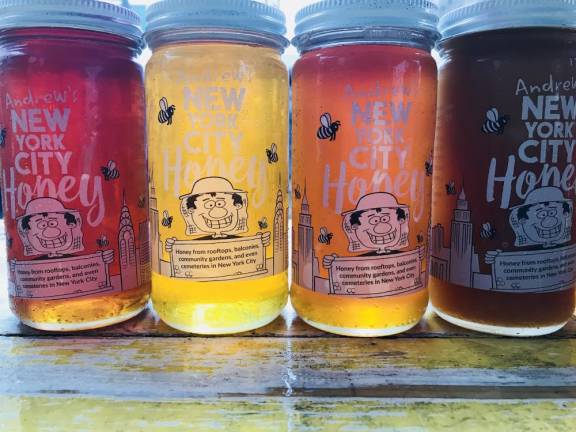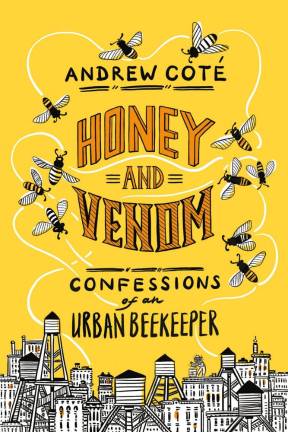The Big Apple is sweeter because of the work of Andrew Coté. A fourth-generation beekeeper who maintains close to 100 beehives and millions of bees in Manhattan alone, he is New York City’s leading expert on all things bee-related. His beehives are abuzz on the grounds of the United Nations, Bryant Park, the roof of the Waldorf Astoria and Brooks Brothers’ flagship location, where there are four hives, one for each of the original brothers. One summer, he even installed a colony as part of a sculpture at MoMA, the first-ever there to employ the use of live animals.
To say the Connecticut-native-turned-Upper West Sider is a busy bee is quite the understatement. His resume is replete with positions such as being the founder of the New York City Beekeepers Association, through which he teaches urban beekeeping classes, and starting the nonprofit Bees Without Borders, where he travels to places like Haiti, Kenya and Iraq to help alleviate poverty through beekeeping. And when beekeeping became legal in New York City in 2010, Coté was the beekeeper the Department of Health and Mental Hygiene consulted with on best practices, and the professional they still turn to with their bee concerns.
His new memoir, “Honey and Venom,” released on June 9, regales readers with stories sometimes illustrious - shooting a commercial with his beehives for New York State directed by Spike Lee, and oftentimes arduous - responding to a call to remove a swarm on the roof of One Times Square.
Every Monday, Wednesday and Saturday, you can find him at the Union Square Greenmarket, where he sells honey from the beehives he tends to around the city. Each jar of Andrew’s Honey is labeled with the neighborhood where the bees lived that produced it.
I gave your book five stars on Goodreads. It’s so interesting and entertaining. Where did you get all your bee knowledge?
Well, I’ve been keeping bees for over 40 years and certainly in that time, I’ve read quite a few books and attended many meetings and lectures. And also, I had a friend of mine, Larry Connor, who’s a beekeeper with a Ph.D. in entomology who specializes in honey bees, read all of the text about the bee facts, just to make sure I didn’t have something wrong.
Explain your family’s history with beekeeping, your father’s role in mentoring you in the field, and how you’re carrying it on to your son now.
Our family began keeping bees in Quebec in the 1800s and it has filtered down all the way to me, but we have not only been beekeepers, and by that I mean it has not been our sole means of support. My father taught me beekeeping and his mother was also a beekeeper, although there was a disconnect when they left the family farm in Canada and moved to Connecticut. My son is not yet five, but during COVID, he has been with me pretty much 24/7 and has been in many a bee yard and rooftop apiary since March. So he has had a trial by fire of beekeeping.
It took you 10 years to get your honey into the Union Square Greenmarket.
That’s right; it took me 10 years to get into the Saturday greenmarket, and I only got in because one man retired. And he died a year after, so it was a lesson to me not to retire. We have a very limited supply of honey from the New York City neighborhoods and we label by neighborhood. So, for example, the bees that I have over the Highline, we write “Highline,” on the lids of those jars, so people know exactly where the honey comes from. We used to have bees on top of the MoMA, and we labeled that “Midtown,” for example.
You started teaching beekeeping classes in 2007, which became so popular they are now always at full capacity.
We generally have them in February and March. Because of COVID, we only had one session this year. We had to cancel our second session because our venue was closed. We limit it to 75 participants per session, and sometimes 50, it just depends on the size of the room. They generally sell out, which is very nice. It’s a real crossroads for different types of people. I have cultivated friendships with people from groups I really wouldn’t think I would have anything in common with, but not for the beekeeping that pulled us together.
Tell us about one of the memorable swarms you had to take care of in Manhattan.
Well, one day I was downtown and got a few alerts that there was a swarm in Times Square. I don’t really take swarm calls too seriously until they land and I get a photograph, because people don’t always know what a swarm is, and a few bees can be a swarm to somebody. I received enough reports about it to head up there. The swarm ended up affixing itself to the very top of One Times Square, which is the building where the ball drops every new year. It was on the end of a beam that hung out over the top of the roof. So it was a little tricky, but we hooked ourselves up to the harness window washers use to cheat gravity, and then shimmied out onto the beam to pick up these 25,000 or so bees with a small vacuum and then placed them in another hive. It turned out we were up on I think it was the 17th floor, right across from the Reuters’ offices. So while we were doing this, it was being very well documented in photographs that were disseminated all over the world.
To learn more, visit AndrewsHoney.com and follow him on Instagram @AndrewsHoney



